• Few operators would claim that the design or construction
Page 34

Page 35
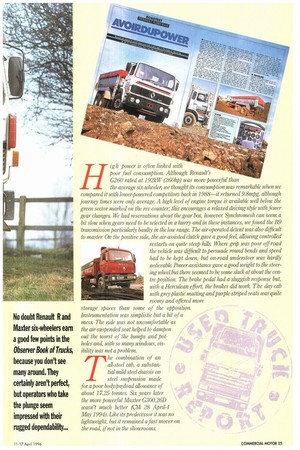
Page 36
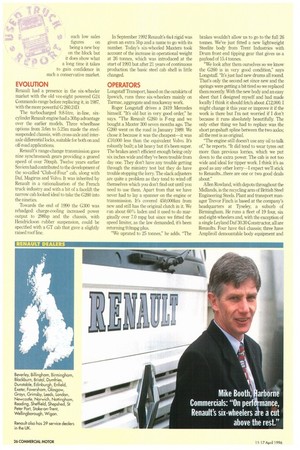
Page 37
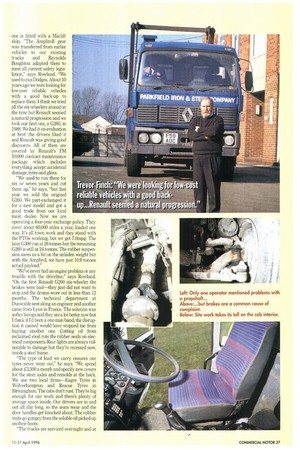
Page 38
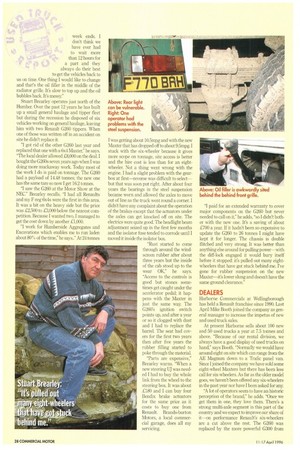
Page 39
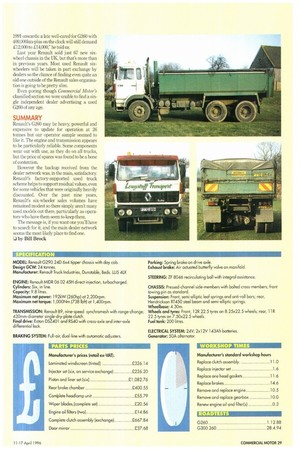
If you've noticed an error in this article please click here to report it so we can fix it.
of any of today's trucks is seriously flawed, although most would agree that some are better than others. While the SMMTs statistics show which are the winners and losers, it is not always clear what makes one truck sell better than another.
Most operators have long-standing preferences but will still stop to consider availability, specification, price, payload, performance, back-up, parts prices and residuals at some point in the transaction.
It may not be in that order as the application and the location of the operator must necessarily influence priorities.
Nine years ago Renault, with a new model, claimed a modest 1.6% of the six-wheeler rigid market in the UK. It took until last year and yet another new model range to improve that share to almost 2.2%, which equates to little more than a tenth of the 6x4s sold by Leyland Daf. Renault can no longer blame 1.•
ig h power is often linked with poor fuel consumption. Although Renault's G260 rated at 192kW (260hp) was more powerful than the average six-wheeler, we thought its consumption was remarkable when we compared it with lower-powered competitors back in 1988—it returned 9.8mpg, although journey times were only average. A high level of engine torque is available well below the green sector marked on the rev counter; this encourages a relaxed driving style with fewer gear changes. We had reservations about the gear box, however Synchromesh can seem a bit slow when gears need to be selected in a hurry and in these instances, we found the B9 transmission particularly baulky in the low range The air-operated detent was also difficult to master On the positive side, the air-assisted clutch gave a good feel, allowing controlled restarts on quite steep hills. Where grip was poor off road the vehicle was difficult to persuade round bends and speed had to be kept down, but on-road understeer was hardly noticeable Power assistance gave a good weight to the steering wheel but there seemed to be some slack at about the centre position. The brake pedal had a sluggish response but, with a Herculean effort, the brakes did work. The day cab with grey plastic matting and purple-striped seats was quite roomy and offered more storage spaces than some of the opposition. Instrumentation was simplistic but a bit of a mess. The ride was not uncomfortable as
the air-suspended seat helped to dampen out the worst of the bumps and potholes and, with so many windows, visibility was not a problem.
The combination of an all-steel cab, a substantial mild steel chassis on steel suspension made for a Poor body/payload allowance of about 17.25 tonnes. Six years later the more powerful Maxter G300.26D wasn't much better (CM 28 April-4 May 1994). Like its predecessor it was no lightweight, but it remained a fast mover on the road, if not in the showrooms. 1-0 such low sales
figures on
44,;,. being a new boy 024, on the block but to 0 7: it does show what a long time it takes to gain confidence in such a conservative market.
EVOLUTION
Renault had a presence in the six-wheeler market with the old vee-eight powered G24 Commando range before replacing it, in 1987, with the more powerful G 260.24D.
The turbocharged 9.8-litre, in-line, sixcylinder Renault engine had a 30hp advantage over the earlier models, Three wheelbase options from 3.6m to 5.25m made the steelsuspended chassis, with cross-axle and interaxle differential locks, suitable for both on and off-road applications.
Renault's range-change transmission gave nine synchromesh gears providing a geared speed of over 70mph. Twelve years earlier Saviem had contributed to the development of the so-called "Club-of-Four" cab, along with Daf, Magirus and Volvo. It was inherited by Renault in a rationalisation of the French truck industry and with a bit of a facelift the narrow cab looked ideal to take the G260 into the nineties.
Towards the end of 1990 the G300 was rebadged: charge-cooling increased power output to 298hp and the chassis, with Hendrickson rubber suspension, could be specified with a GT cab that gave a slightly raised roof line.
In September 1992 Renault's 6x4 rigid was given an extra 5hp and a name to go with its number. Today's six-wheeled Maxters took account of the increase in operational weight at 26 tonnes, which was introduced at the start of 1993 but after 21 years of continuous production the basic steel cab shell is little changed.
OPERATORS
Longstaff Transport, based on the outskirts of Ipswich, runs three six-wheelers mainly on Tarmac, aggregate and muckaway work.
Roger Longstaff drives a 2419 Mercedes himself. "It's old but in very good order," he says. "The Renault G260 is F-reg and we bought a Maxter 300 seven months ago. The G260 went on the road in January 1989. We chose it because it was the cheapest—it was .£10,000 less than the equivalent Volvo. It's robustly built; a bit heavy but ifs been super. The brakes aren't efficient enough being only six inches wide and they've been trouble from day one. They don't have any trouble getting through the ministry test but they do have trouble stopping the lorry. The slack adjusters are quite a problem as they tend to wind off themselves which you don't find out until you need to use them. Apart from that we have never had to lay a spanner on the engine or transmission. It's covered 450,0001un from new and still has the original clutch in it. We run about 60% laden and it used to do marginally over 7.0 mpg but since we fitted the speed limiter, as the law demanded, it's been returning 9.0mpg plus.
"We uprated to 25 tonnes," he adds. "The brakes wouldn't allow us to go to the full 26 tonnes. We've just fitted a new lightweight Steelite body from Trent Industries with Drum front end tipping gear that gives us a payload of 15.4 tonnes.
"We look after them ourselves so we know the G260 is in very good condition," says Longstaff. "It's just had new drums all round. That's only the second set since new and the springs were getting a bit tired so we replaced them recently. With the new body and an easy sheet that I designed myself and had made locally! think it should fetch about 112,000.1 might change it this year or improve it if the work is there but I'm not worried if I don't because it runs absolutely beautifully. The only other thing we had to replace was the short propshaft spline between the two axles; all the rest is as original.
"The engine still doesn't use any oil to talk of," he reports. "It did tend to wear tyres out more than previous lorries, which we put down to the extra power. The cab is not too wide and ideal for tipper work. I think it's as
good as any other lorry I expect we'll stick to Renaults.. there are one or two good deals about."
Allen Rowland, with depots throughout the Midlands, is the recycling arm of British Steel Engineering Steels. Plant and transport manager Trevor Finch is based at the company's headquarters at Tyseley, a suburb of Birmingham. He runs a fleet of 19 four, six and eight-wheelers and, with the exception of a single Leyland Daf 30.30 Constructor, all are Renaults. Four have 6x4 chassis; three have Ampliroll demountable body equipment and one is fitted with a IVIaclift skip "The Ampliroll gear was transferred from earlier vehicles to our existing trucks and Reynolds Boughton adapted them to meet all current safety legislation," says Rowland. "We used to run Dodges. About 10 years ago we were looking for low-cost reliable vehicles with a good back-up to replace them. I think we tried all the six-wheelers around at the time but Renault seemed a natural progression and we took our first one, a G260, in 1988. We had it on evaluation at first: the drivers liked it and Renault was giving good discounts. All of them are covered by Renault's FM 10,000 contract maintenance package which includes everything accept accidental damage, tyres and glass.
"We used to run them for six or seven years and cut them up," he says, "but last year we sold the original G260. We part-exchanged it for a new model and got a good trade from our local main dealer. Now we are operating a four-year exchange policy They cover about 60,000 miles a year, loaded one way It's all town work and they stand with the PTOs working, but we get 7.0mpg. The later G300 run at 26 tonnes but the remaining G260 is still at 24 tonnes. The rubber suspension saves us a bit on the unladen weight but with the Amplirol, we have just 10.9 tonnes actual payload," "We've never had an engine problem or any trouble with the driveline," says Rowland. "On the first Renault G260 six-wheeler the brakes were bad—they just did not want to stop and the drums wore out in less than 12 months. The technical department at Dunstable sent along an engineer and another came from Lyon in France. The solution was softer linings and they are a lot better now but I think if I'd been a one-man band, the disruption it caused would have stopped me from buying another one. Cutting oil from reclaimed steel rots the rubber seals on electrical components. Rear lights are always vulnerable to damage but they're recessed now, inside a steel frame, The type of load we carry ensures our tyres never wear out," he says. "We spend about £3,500 a month and specify new covers for the steer axles and remolds at the back. We use two local firms—Eagre Tyres in Wolverhampton and Rescue Tyres in Birmingham. The cabs don't rust They're big enough for our work and there's plenty of storage space inside. Our drivers are in and out all day long, so the seats wear and the door handles get knocked about. The rubber mats go gungey from the soluble oil picked up on their boots, "The trucks are serviced overnight and at
week ends. I don't think we have ever had to wait more than 12 hours for a part and they always do their best to get the vehicles back to us on time. One thing I would like to change and that's the oil filler in the middle of the radiator grille. It's slow to top up and the oil bubbles back. It's messy."
Stuart Brearley operates just north of the Humber. Over the past 12 years he has built up a small general haulage and tipper fleet but during the recession he disposed of six vehicles working on general haulage, leaving him with two Renault G260 tippers. When one of those was written off in an accident on site he didn't replace it.
"I got rid of the other G260 last year and replaced that one with a 6x4 Maxter," he says. "The local dealer allowed £8,000 on the deal. I bought the G260s seven years ago when I was doing more muckaway work. Today most of the work I do is paid on tonnage. The G260 had a payload of 14.48 tonnes; the new one has the same tare so now I get 16.2 tonnes.
"I saw the G260 at the Motor Show at the NEC." Brearley recalls. "I had all Renaults and my F-reg 6x4s were the first in this area. It was a bit on the heavy side but the price was £2,500 to £3,000 below the nearest competition. Because I wanted two, I managed to get the cost down by another £1,000.
"I work for Humberside Aggregates and Excavations which enables me to run laden about 80°0 of the time," he says.." At 24 tonnes I was getting about 10.5mpg and with the new Maxter that has dropped off to about 9.5mpg. I stuck with the six-wheeler because it gives more scope on tonnage, site access is better and the hire cost is less than for an eightwheeler. Not a thing went wrong with the engine. I had a slight problem with the gearbox at first—reverse was difficult to select but that was soon put right. After about four years the bearings in the steel suspension became worn and allowed the axles to move out of line as the truck went round a corner. I didn't have any complaint about the operation of the brakes except that the actuators under the axles can get knocked off on site. The electrics were quite good. The headlight beam adjustment seized up in the first few months and the isolator fuse tended to corrode until I moved it inside the isolator box.
"Rust started to come through around the windscreen rubber after about three years but the inside of the cab stood up to the wear OK," he says. "Access to the controls is good but stones sometimes get caught under the accelerator pedal; it happens with the Maxter in just the same way. The G260's ignition switch points up, and after a year or so it clogged with dust and I had to replace the barrel. The seat had covers for the first two years then after five years the rubber filling started to poke through the material.
"Parts are expensive," Brearley warns. "When a new steering UJ was needed I had to buy the whole link from the wheel to the steering box. It was about £180 and I can buy four Bendix brake actuators for the same price as it costs to buy one from Renault. Brands-burton Motors, a local commercial garage, does all my servicing.
"I paid for an extended warranty to cover major components on the G260 but never needed to call on it," he adds, "so I didn't bother with the new one. It's a saving of about £700 a year. If it hadn't been so expensive to update the G260 to 26 tonnes I might have kept it for longer. The chassis is double flitched and very strong. It was better than anything else around for pulling power—with the diff-lock engaged it would bury itself before it stopped: it's pulled out many eightwheelers that have got stuck behind me. I've gone for rubber suspension on the new Maxter—it's lower slung and doesn't have the same ground clearance."
DEALERS
Harborne Commercials at Wellingborough has held a Renault franchise since 1990. Last April Mike Booth joined the company as general manager to increase the impetus of new and used truck sales.
At present Harborne sells about 100 new and 50 used trucks a year at 7.5 tonnes and above. "Because of our rental division, we always have a good display of used trucks on hand," says Booth. "Normally we would have around eight on site which can range from the AE Magnum down to a Trafic panel van. Since I joined the company we have sold some eight-wheel Maxters but there has been less call for six-wheelers. As far as the older model goes, we haven't been offered any six-wheelers in the past year nor have I been asked for any.
"A lot of operators seem to have an historic perception of the brand," he adds. "Once we get them in one, they love them. There's a strong multi-axle segment in this part of the country and we expect to improve our share of it—on performance Renault's six-wheelers are a cut above the rest. The G260 was replaced by the more powerful G300 from
1991 onwards: a late well.cared for G260 with 400,000krn-plus on the clock will still demand 1:12,000 to £14,000," he told us.
Last year Renault sold just 67 new sixwheel chassis in the UK, but that's more than in previous years. Most used Renault sixwheelers will be taken in part exchange by dealers so the chance of finding even quite an old one outside of the Renault sales organisation is going to be pretty slim.
Even poring though Commercial Motor's classified section we were unable to find a single independent dealer advertising a used G260 of any age.
SUMMARY
Renault's G260 may be heavy, powerful and expensive to update for operation at 26 tonnes but our operator sample seemed to like it. The engine and transmission appears to be particularly reliable. Some components wear out with use, as they do on all trucks, but the price of spares was found to be a bone of contention.
However the backup received from the dealer network was, in the main, satisfactory. Renault's factory-supported used truck scheme helps to support residual values, even for some vehicles that were originally heavily discounted. Over the past nine years, Renault's six-wheeler sales volumes have remained modest so there simply aren't many used models out there, particularly as operators who have them seem to keep them.
The message is, if you want one you'll have to search for it, and the main dealer network seems the most likely place to find one.
Ul by Bill Brock




























































































































